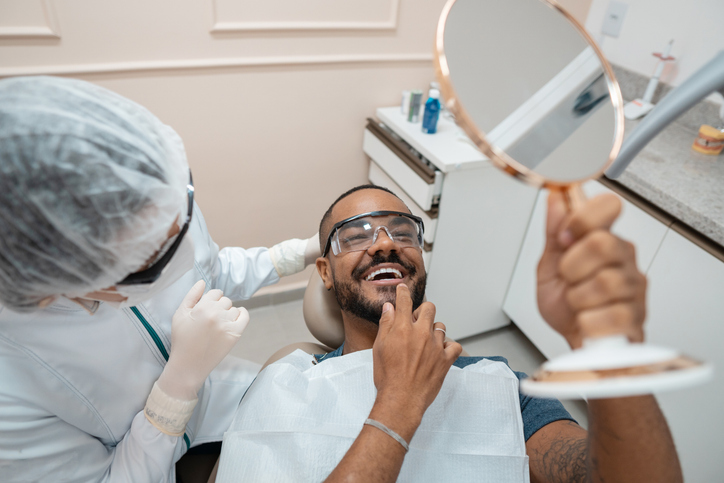
Introduction to Dental Implant Recovery
The dental implant procedure involves placing a titanium post into the jawbone, which acts as a replacement for a natural tooth root. After the implant is inserted, the healing process begins, and your body starts to bond with the implant through a process called osseointegration. This bonding is key to the implant’s long-term stability and success.
Recovery from dental implant surgery is not immediate; it’s a process that unfolds over several stages. While recovery times can vary from patient to patient, having a clear understanding of what each stage entails will help you be more prepared for your journey toward a restored smile. Today, we will outline each stage of recovery so you know what to expect and how to take care of yourself during each phase.
Stage 1: Immediate Post-Surgery (First 24-48 Hours)
Immediately after your dental implant surgery, it’s normal to experience some swelling, minor bleeding, and discomfort around the surgical site. During the first 24-48 hours, your body is beginning the process of healing. This initial stage is critical, and there are a few key things to keep in mind to ensure a smooth start to your recovery.
You may notice swelling around the gums and jaw, which is a natural response to surgery. Swelling typically peaks within 48 hours and gradually subsides after that. To manage swelling, you can use an ice pack applied to the outside of the cheek near the surgery site in 15-minute intervals.
Bleeding is another common symptom right after surgery. Slight oozing from the site is normal, but if you experience heavy bleeding, it’s important to follow the post-operative instructions you received from your periodontist. Applying gentle pressure with gauze should help control it.
For managing discomfort, your periodontist will likely prescribe medication or recommend over-the-counter options. It’s important to take these as directed and avoid strenuous activities during the first few days. By carefully following your post-op instructions, you’ll set the stage for a smooth recovery.
Stage 2: The Healing Phase (First Week)
As you move into the first week of recovery, you’ll notice that the initial swelling and discomfort start to diminish. Most patients find that by the end of the first week, they are feeling more comfortable. However, this period still requires extra care.
During this stage, you’ll want to stick to soft foods like yogurt, mashed potatoes, and scrambled eggs to avoid putting pressure on the surgical site. Hard or chewy foods should be avoided, as they can disrupt the healing process.
Maintaining good oral hygiene is vital during this time, but you’ll need to be gentle around the surgical area. Your periodontist will provide specific instructions for cleaning around the implant site. You may be advised to rinse with a saline solution or prescribed mouthwash to reduce the risk of infection.
Bruising may still be visible, but it should start to fade as you move further into recovery. Patience and care during this phase will ensure your implant heals properly and sets the stage for the next steps in the process.
Stage 3: Osseointegration (Weeks to Months)
One of the most critical stages of dental implant recovery is osseointegration, which can take several weeks to several months. During this time, the titanium post that was placed in your jawbone begins to fuse with the bone, creating a stable foundation for your future crown or prosthesis. This process is the key to a successful implant, as it ensures the long-term durability of your new tooth.
It’s important to remember that osseointegration takes time. While some patients may feel ready for the next step sooner, rushing the process can lead to complications. During this phase, patience is essential.
To support healing during osseointegration, maintaining excellent oral hygiene is critical. Continue to brush and floss regularly, being mindful of the surgical area. Avoiding habits like smoking is especially important, as smoking can interfere with the body’s ability to heal and increase the risk of implant failure.
Your periodontist will schedule follow-up visits to monitor the healing process and make sure osseointegration is progressing as expected. These appointments are vital to ensuring the implant is integrating properly and that your mouth is healing well.
Stage 4: Final Recovery and Crown Placement (Months Later)
Once osseointegration is complete, you’ll enter the final stage of your dental implant recovery. This stage typically occurs several months after surgery, depending on how well your body has responded to the implant. At this point, your periodontist will confirm that the implant is fully integrated into the jawbone, and you’ll be ready for the placement of the permanent crown or prosthesis.
This is an exciting phase, as your dental implant will start to look and function just like a natural tooth. The crown placement is the final step in the implant process, and once it’s completed, your smile will be fully restored.
Even after your crown is placed, it’s important to continue caring for your implants just as you would your natural teeth. Regular brushing, flossing, and dental check-ups are key to maintaining your implant and preventing issues like peri-implantitis (an infection around the implant).
Routine follow-up visits with your periodontist will help ensure that your implant remains healthy for years to come. Maintaining a proactive approach to your oral health will give you the best chance for long-term success.
Wrapping Up Your Dental Implant Journey
Dental implant recovery is a multi-step process that requires care, patience, and close attention to your periodontist’s guidance. From the immediate post-surgery phase through osseointegration and final crown placement, understanding each stage of recovery will help you feel more confident about your treatment and ensure your implant heals properly.
If you have any questions about your recovery or are considering dental implants, don’t hesitate to reach out to us at Implant & Perio Center of Kansas. Our team is here to guide you every step of the way and help you achieve a healthy, lasting smile.
